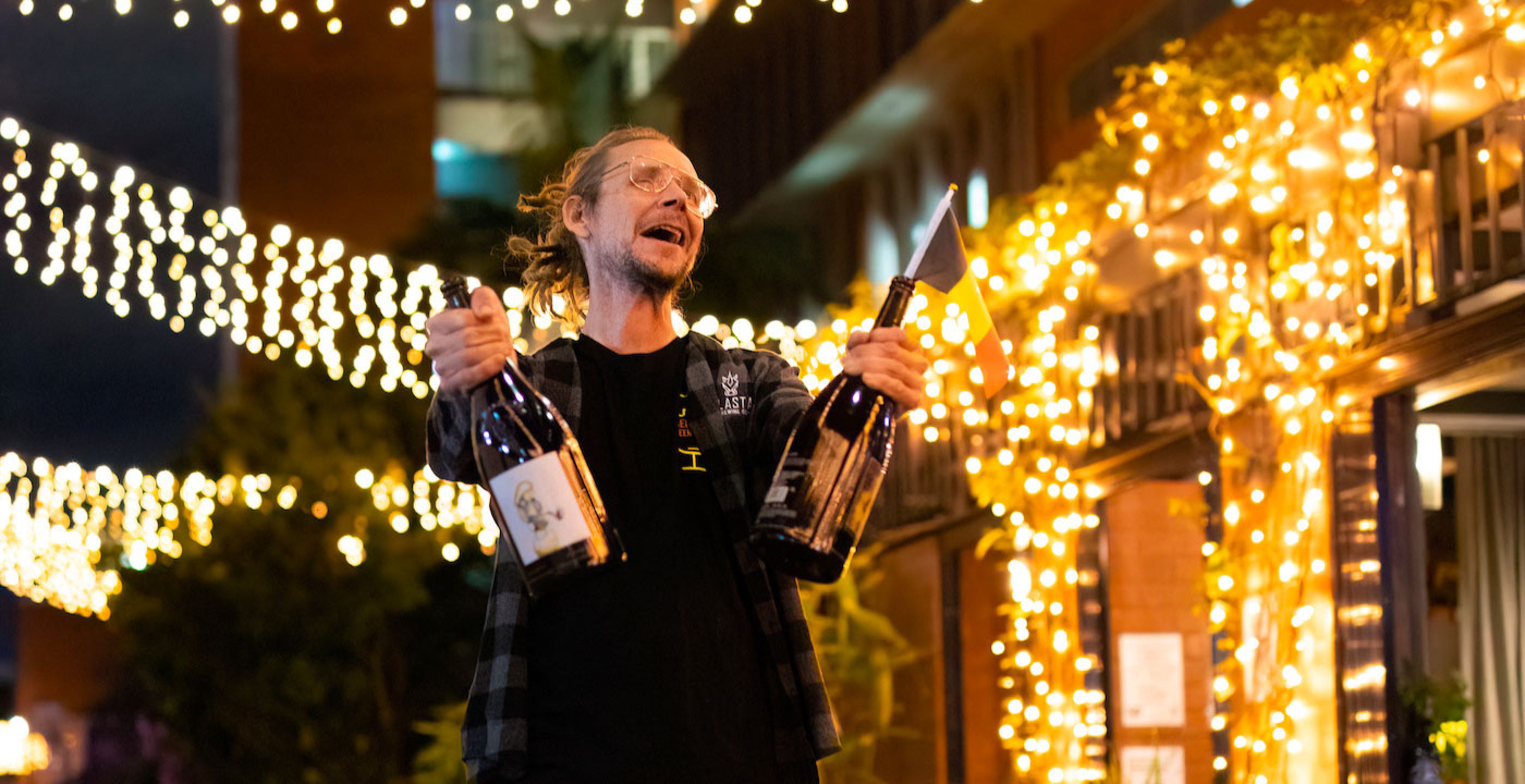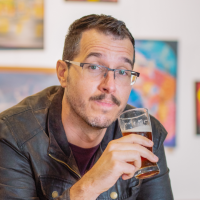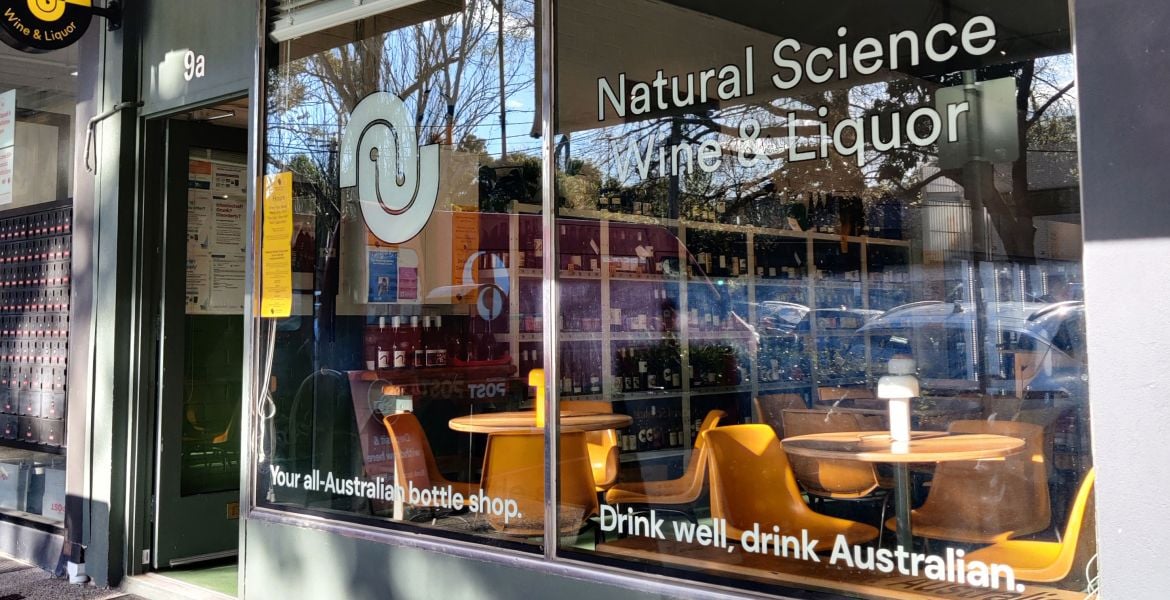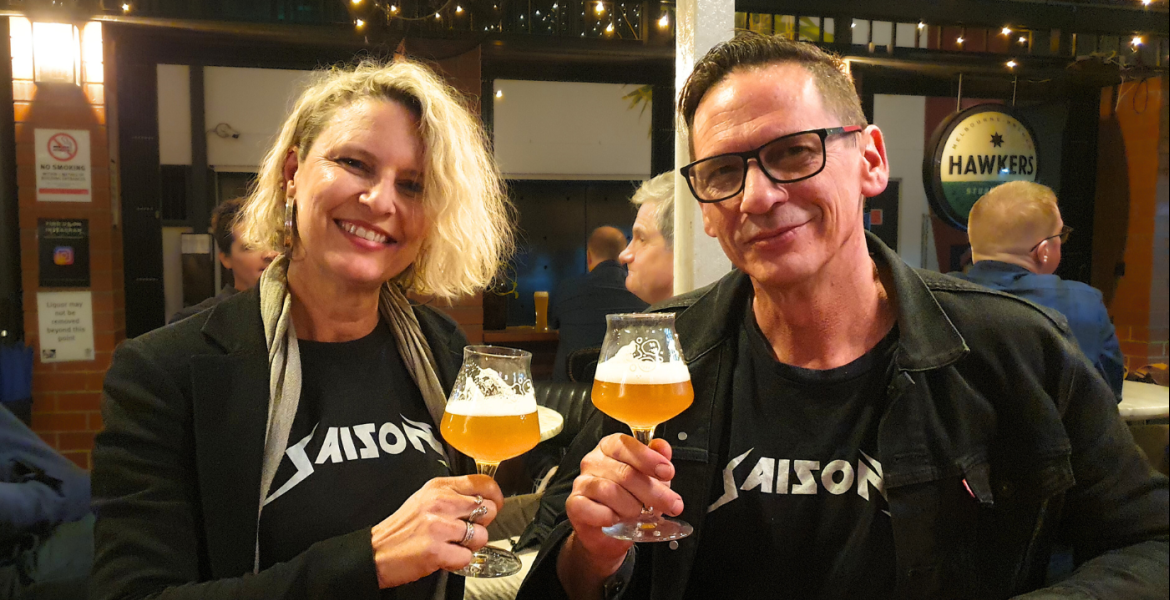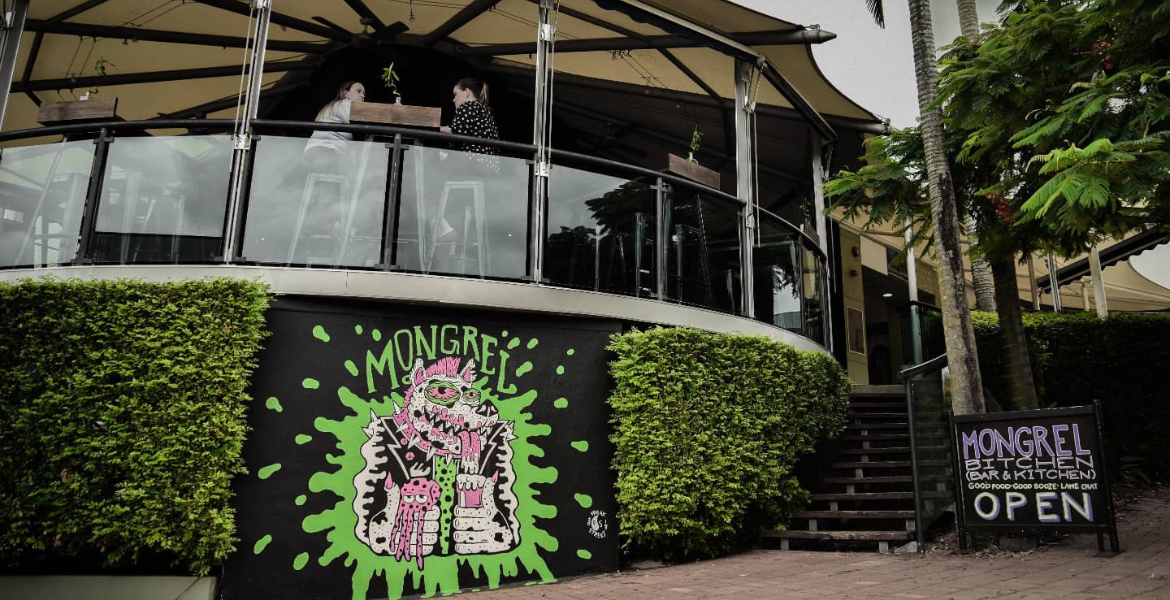During the day, Fish Lane doesn’t look like much: brick walls, concrete, bitumen. Don’t get me wrong: there are some nice street art installations. But, you know, there's also a bunch of industrial bins. So you’d be forgiven for not instinctively expecting to find a beer haven like Saccharomyces Beer Café nestled in there.
At night, however, when Fish Lane is a tunnel of golden festoon lights that twinkle like a magical fairy wonderland, it’s easier to be drawn into co-owner Simon Booy’s vision of a magical beery wonderland: a world of fresh IPAs and farmhouse ales and Belgian meatballs.
Mick Wüst joined him to trace both his and the venue's role in the evolution of Brisbane's craft beer scene, as well as his thoughts on the future of craft beer in Australia, for our Behind Bars series.
A Change Of Direction
Saccharomyces is a far cry from Simon’s former life, when he was working in retail pharmacy for ten years. On the side, he'd been nurturing a passion for beer by dabbling in homebrewing and enjoying his weekly ritual of finding new beers to try (which required rather more effort back in 2011 than it does today).
“Walk into Dan Murphy’s and go down the European aisle. It was always fun, getting something different every week,” he says. “Getting all the imports … Chimay, and all those classics that were available in the early days.”
Since he never really enjoyed his time as a pharmacist and was looking for a way out, Simon went back to uni to do an MBA. His dream: to open a brewery and share his beer with others.
“The drugs people want to buy, not the drugs they need!” is how he puts it.
He wanted to partner up with a friend – Dom Alexander, who’s soon to open Caldera Brewing & Blending – to open a brewery with a taphouse in the city, since only Brewhouse Brisbane was doing anything like that at the time. Who better to run a business centred around fermentation than a pharmacist and a chemical engineer?
But this episode of Breaking Bad didn’t make it to the final stages of production. On a trip to Europe in 2012, Simon made a stopover in Singapore and got chatting with the owner of RedDot Brewhouse. It was here that he was hit with the harsh reality that he’d need upwards of half a million dollars to pull off his idea for a brewery, and thought, “Yeah… that’s a bit much.”
Although the plan to open a brewery came to a stop, Simon was still keen to move out of pharmacy and into beer. So he engineered a slight course correction and decided to go from filling scripts to filling schooners: he’d open a bar.
Blazing A (Small) Trail

In many ways, opening a bar is easier than opening a brewery. But that doesn’t mean it’s easy.
First, there’s the build. In the case of Saccharomyces, that meant turning a walled garden bed in a dinky back lane into a bar inspired by the beer halls Simon had visited in Germany. (Fish Lane wasn’t very sexy at this time – the street art and festoon lights and chic bars were still to come.)
You’d think starting from scratch and building everything to purpose would make it all work smoothly. You’d be wrong. The Sacc team had architects, and the building owners had architects, and the project required them to work together. But when Sacc’s architects turned up on site, they were met with their first big problem: a concrete floor that was a touch uneven.
“Our architects pulled up, and they’d just decided to pour the slab on a slant! One end was a metre-and-a-half higher than the other.”
(When Simon told me this, I laughed and said: “Isn’t architects’ whole job to design workable spaces?” He replied with a sigh: “They design pretty spaces, not workable spaces.”)
There were other problems as well – no exhaust in the kitchen; cold food storage at the opposite end of the bar to the kitchen; the bar being installed 30cm lower than the fridges that needed to fit underneath it – but they eventually got the fitout done, and the team faced their next hurdle: licensing.
Saccharomyces didn’t meet the requirements for the relatively new small bar licence (too many seats), and didn’t meet the requirements for a restaurant licence (the ratio of drinks to food orders didn’t line up).
“Weird licensing laws… Either you’re a shoebox bar or you’re a mega pub,” Simon says.
In the end, they applied for a hotel licence, but were knocked back because they didn’t have a separate function room – a seemingly arbitrary requirement that’s been in place for years.
Putting on his best bureaucratic voice, Simon declares: “‘That’s what pubs have been since nineteen-dickety-four.’”
Thankfully, with help from liquor licensing guru Russell Steele, they were able to appeal the rejection due to a lack of specificity in the legislation.
“Doesn’t say the function room has to be a certain size,” says Simon, pointing to a table tucked into an alcove around the corner. “Just has to be separate.”
With this, Saccharomyces received one of the first small hotel licences, and became a trailblazer for other venues.
“There’s now quite a few around with a hotel licence that are our sorta size.”
A World Of Beer

While 2015 is only eight years ago, it was a different world when Saccharomyces opened. These were the days when Citra and Mosaic were hot varieties in Australia rather than "classic". This was before West Coast IPAs were considered "old school". This is a time when hardly any Aussie brewers would make a saison, and they’d work on quads at the gym rather than at the brewery.
And so, while there were more than a handful of Australian breweries making great stuff, one of the ways Simon provided a niche experience (while feeding his own inner beer geek desires) was by looking overseas. He’d bring in rare and novelty and excellent beers from breweries around the world, whether that be imperial stouts from Nøgne Ø, IPAs from Stone, or a honeydew and yuzu sour from Garage Project.
“Wabi Sabi. That was a risk. People weren’t keen on paying $18 a schooner back then,” he says. “It was a shock for me paying $800 for a keg!”
But Saccharomyces was very much a destination for people who appreciated beer (Fish Lane wasn’t sexy and full of pedestrians in 2015), so it managed to find its tribe. This is also how Simon managed to put bums on seats for some of the best beer events in Brisbane. Over the years, Saccharomyces has put on beer matching dinners, tap takeovers and multi-day festivals that make even the most seasoned beer veterans cry tears of joy.
Like when they go all out on Oktoberfest, pitching imported Bavarian beers against Aussie versions of Bavarian beers, or clean lagers from Weihenstephan up against smoky beers from Schlenkerla.
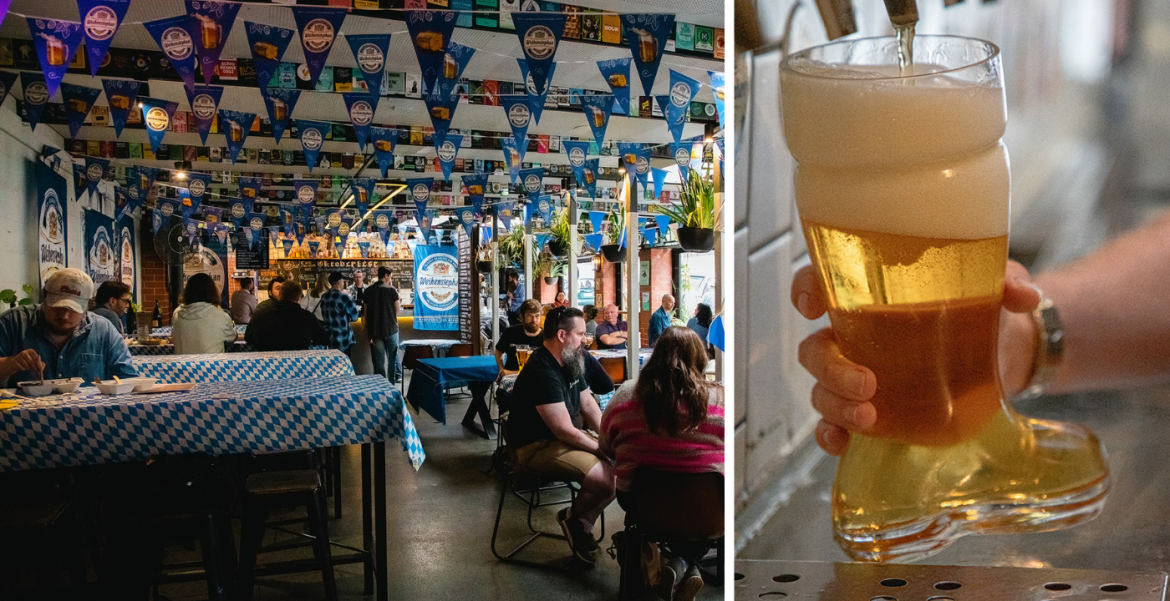
Or like the time Sacc transformed into a Mikkeller bar, partnering with Mikkeller and Copenhagen’s WarPigs Brewpub to serve up authentic Scandinavian craziness for a weekend.
Possibly the biggest event on the Sacc calendar, however, is Belgian Beer Week.
“Originally it was one giant day, and I got more and more excited,” Simon says sheepishly.
No one’s complaining. Saccharomyces has kind of transitioned from German-beer-hall-vibes to Belgian-beer-café-vibes anyway, and when Belgian Beer Week involves magnums of Chimay Grand Reserve, video chats with Belgian breweries, and more than 40 imported beers (mostly with branded matching glassware), there’s plenty of excitement to go round. Following their Quads & Cheese event this year, they even had some St Bernardus ABT12 washed rind cheese specially made; it was soaked in the beer for 48 hours then painted with it each day as it aged in a cave. How is this even a thing?!
With all of this, though, don’t go getting the impression Saccharomyces is just focussed on imported beer. Aussie independent beers are Sacc’s bread and butter. They fill the taps, they fill the fridges, and there seems to be a new Sacc collab every other month.
Like the one they made with Slipstream, where they invited a string quartet to play to the beer as it was being brewed, then got the quartet back in to play for punters as they drank the beer.
Or the one where they dumped a heap of cream sponge cake into the boil of a NEIPA at Sea Legs (it was Sacc’s fifth birthday, after all).
Or the one where they passed the dregs of their keg of Cantillon Zwanze to Black Hops AWOL to make a barrel-aged blonde ale.
Suffice it to say, Saccharomyces has done a lot for the Brisbane beer scene in eight years – and that’s before we even get to the Saccharomyces Bottle Shop in Taringa, which spreads the Sacc love across the river and further with its online store. That’s a story for another day.
For now, let’s hear from Mr Sacc himself, Simon Booy, as we have a look Behind Bars at Saccharomyces Beer Café.
Simon Booy

What was the intention when you launched your venue?
Early, early on in the Saccharomyces planning days –years before we opened, my initial idea was for a brewery, but quickly finding out that was well beyond my financial and technical capabilities, I started with the bar. A bar that only sold independently owned beer and wine.
It was the days where every tap was owned by CUB or Lion, so I wanted to showcase all those great bevies that were not easily found. I wanted a place that also left behind any of the wank and exclusivity that can surround niche food and beverage interests. It was to be a place anyone could hang out, feel comfortable and take ownership: This is your place as much as mine.
How has your venue evolved over the years?
The venue has evolved with the location. A lot happens over eight years. We opened in a dark, scary-looking laneway that no one had heard of, with just Julius Pizzeria and Wandering Cooks for company. Sprinkle in a few extra festoon lights and half a dozen new 30-storey buildings within a block, and suddenly (eight years later) you have a bar in a destination people want to be at. Or at least have heard of.
The increase in foot traffic and unsuspecting customers meant small concessions in the offering. We have added a larger range of spirits and cocktails. We still use independent makers, so have not stooped to black rats on tap.
We initially opened as an all-day venue, selling coffee and breakfast in the morning and slinging the good brews at night. It turns out breakfast and coffee are more of a convenience item than a destination food, and there were not enough people around to keep it going. After about four years, I ended the morning service and put all my efforts into what I actually cared about: the beer.
The closing of the morning also gave more time to consider the food options. Up until that point it had been just paint by numbers: shitty pizzas, average burgers and wings. Food was also difficult as we are limited by the shoebox of a kitchen with no exhaust. I found inspiration in the land of beer, Belgium. Belgian Boulets (big meatballs) have become the hero of the menu and we have created a Belgian-inspired menu around that.
We've also grown from ten taps to 17 taps.
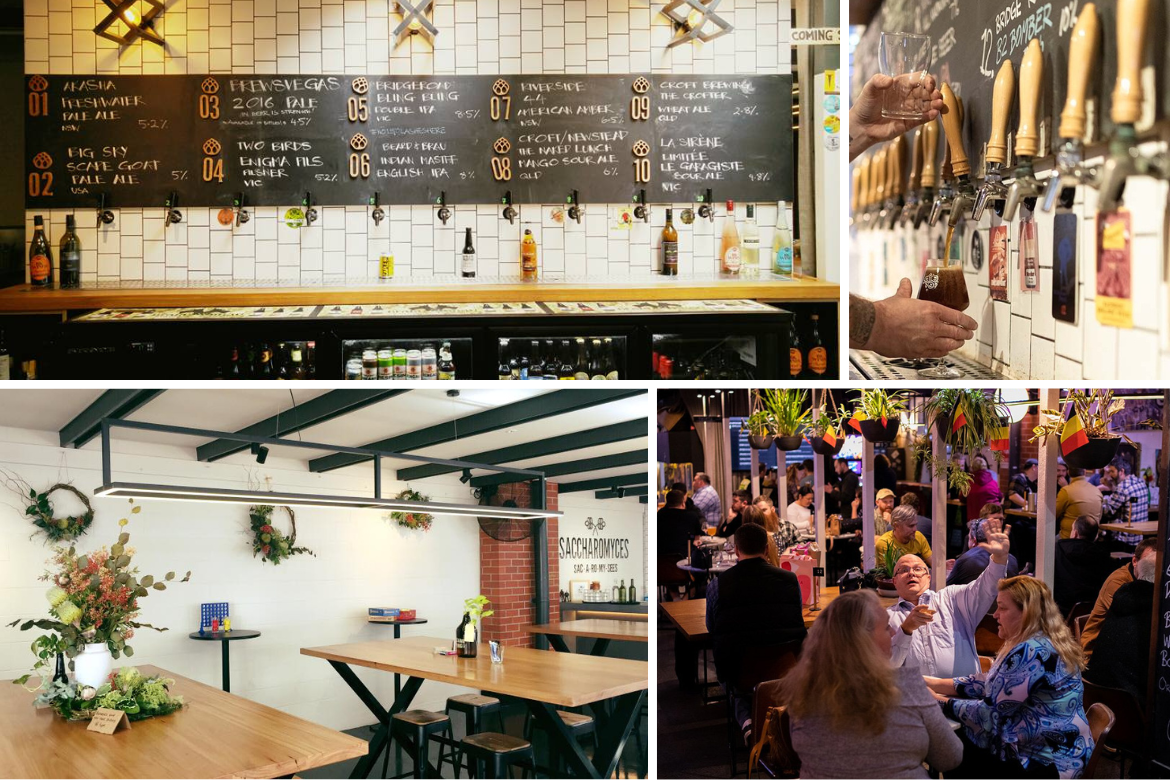
How has the beer scene around you changed?
Eight years ago doesn’t seem like long, but it was early for Aussie craft. Everything came in bottles, and there wasn’t a brewery taphouse in every inner-city suburb of Brisbane. I don’t think there was anyone brewing close to central Brissy except for BBCo. Breweries were set up in smaller surrounding towns – Gold Coast, Mount Tamborine…
We started the bar with ten taps and always had a tap map in which we balanced the beer styles across the taps. That made it a challenge to find dark or sour brews throughout the whole year. Smaller breweries just didn’t brew those styles consistently. It was all pales and IPAs.
The earlier days we also relied on more imports as there just weren’t enough local breweries around. Now it is hard to find room for the imports and sometimes even the local releases we really want. A good evolution.
"Craft" beer has also become more acceptable to the general public. It is no longer just a weird little niche. A lot more people are willing to try something different or new.
What's proving popular with punters at the moment?
Hop forward beers were always the driving force of the early craft days as the USA movement took hold over here. I think this is still the case but from a different perspective, with less bitterness and sweeter hazy beers been more popular than the dank Westies of old. It seems like sweet is the new driving factor, with smoothie sours and lactose IPAs.
It is all turns and roundabouts. I think people just want good, interesting beer.
How you seen a change in your customers or their tastes over the years?
Loving the sweeter beers (as above), but strangely no big increase in the dark beers.
How do you see your venue evolving over the next five years?
We have always been an event-focused bar. In the beginning, it was essential to convince people to venture down a shoddy-looking laneway usually reserved for smoking crack. I haven’t been able to shake that events bug. They are just getting bigger.
Belgian Day has turned into a weeklong celebration, Oktoberfest extends over two weekends. I would love to see these evolve into larger festival-style events.
As South Brisbane increases in residential density, our little local community is growing. We already have quite the consistent little reg crew. I think an as our community grows, Saccharomyces will continue to play a bigger role with the locals.
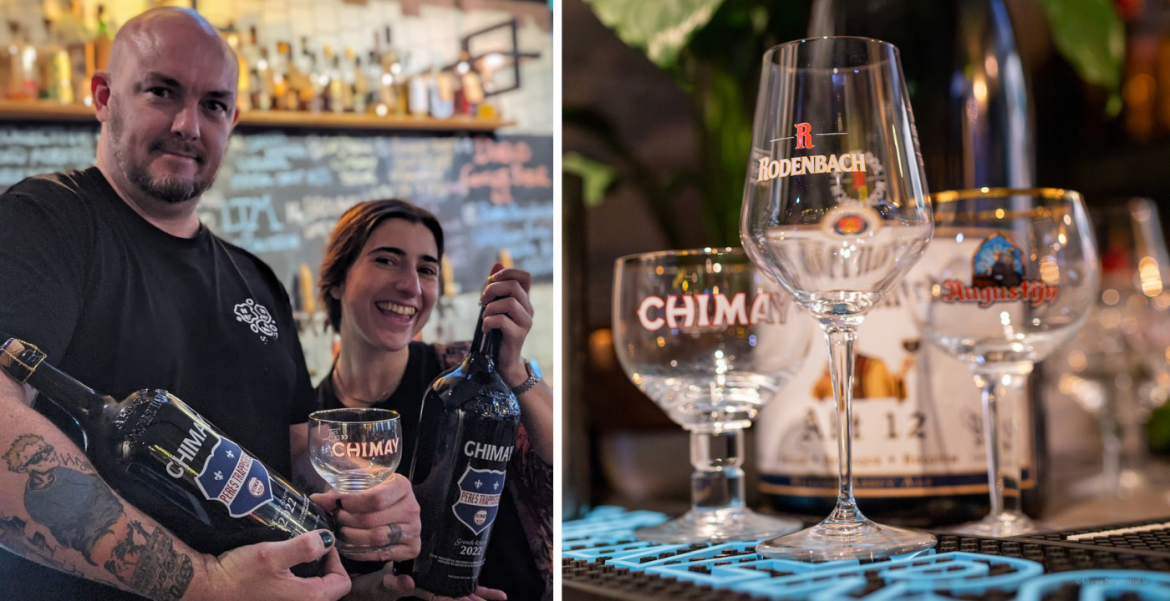
What beers and local breweries have been blowing your mind recently?
So many. Hiker are doing great stuff. Amazing experiments are been concocted at Working Title. Range is known for throwing out juice bombs, but the stout series and sours are cracking. I love breweries like Madocke and Heads of Noosa that just brew their style and brew it well.
Are there any hidden gems – beers, breweries, venues, events – you feel deserve more attention?
I am really looking forward to Caldera Brewing & Blending. They are yet to official release any beer but are another brewery that will just do their own thing: wild ferments and blending. Hopefully we’ll see some goods early next year.
Juicy and Blobfish festivals are fantastic style-orientated events that I would love to see more of in beer festivals.
What styles and trends do you see taking off? Or, for that matter, fading away?
I think the farmhouse brews are due for their time in the sun, but that is just me being selfish. Who knows – saison might be the new pale…
But along that line, I think people are appreciating more traditional brews. Now we are seeing an increase in popularity of clean German style lagers and a slight uptick in the Belgian style blondes and wits.
Any thoughts on where beer in general is heading?
We have reached peak brewery and are seeing a bit of a contraction. I think this will boost the quality of the breweries that survive.
People are spending less, but are willing to spend more on a quality product. I think this will cause a more targeted response in beer. Breweries will be more product- rather than brand-focused. Pretty much like the early days.
I think we are going full circle.
If you had the power to guide the Australian beer scene with a benevolent hand, what one change would you make?
Introduction of the Straya IPA Purity Laws: an IPA cannot have lactose as an adjunct.
You can read more entries in our Behind Bars series here.





